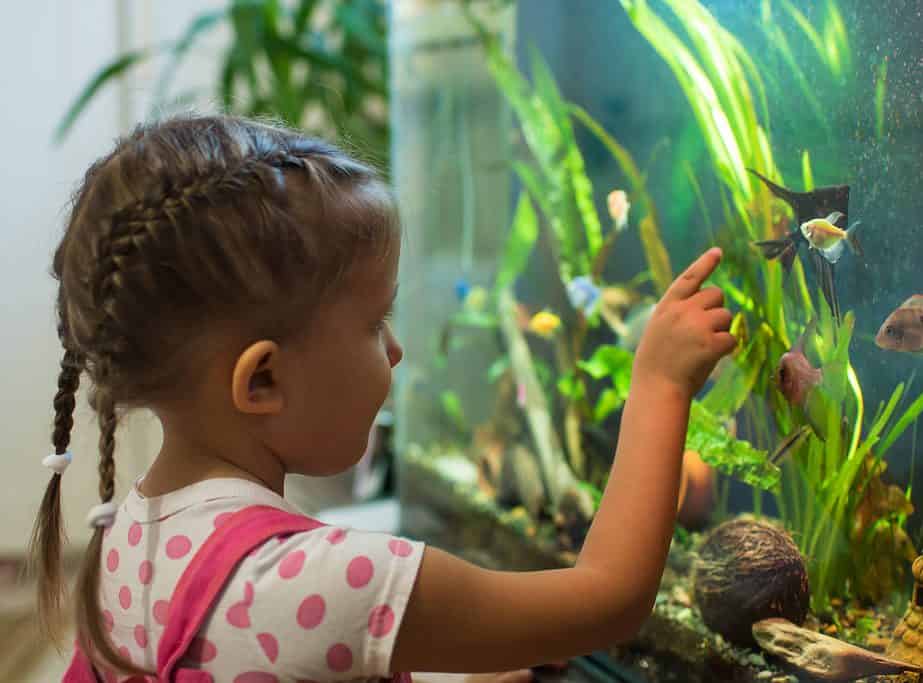
There is an array of factors to keep in mind before welcoming a pet for a young child, especially as young as two or three years old. Are fish good pets for families with toddlers or preschoolers in the household?
Pet fish are great for toddlers and young kids in general. They provide great learning value through observation and opportunities to participate in fun chores, such as feeding the fish. Fish also do not cause allergies and are relatively low-maintenance and inexpensive to care for.
There are interactions and some maintenance points to be aware of when deciding if fish could be good pets for your household.
FISH AS PETS FOR YOUNG CHILDREN
1. An Aquarium Provides Learning Opportunities
Although fish are not as interactive as furry pets, they still have much to offer regarding positive learning experiences. Very young children, in particular, learn from everything in their immediate environment and find wonder in things that we consider mundane and uneventful.
Fish can be fascinating to watch for a kid. Seeing how their shade changes depending on the lighting, watching the interactions of the fish, and how they eat pellets of food – are all fun things to see for a young kid.
Discussing what you see in the aquarium expands your child’s vocabulary and knowledge of the world. Having an aquarium also offers topics to explore the world around.
2. Pet Fish Provide Activity Options
Although your child should not touch fish and petting is not an option like with many other pets, there are still ways to interact and play with fish in your aquarium.
Your toddler might enjoy drawing doodles on the tank, using washable markers. Many fish become curious and watch the process. It helps them recognize the people in their lives and provides the stimulation fish need like most other pets.
Some fish learn to swim through a little hoop while getting to a food pellet. Kids have fun with games like that. As your child matures, he or she might be able to take on some responsibilities when it comes to the maintenance needs of your fish.
3. Fish May Have a Therapeutic Effect
Fish and smooth movements in the water could be relaxing, especially if the tank is beautifully decorated.
This peer-reviewed report is a review of 19 different journal articles to explore the effect of observing and interacting with fish in aquariums. While some studies found no effect, others concluded that watching pet fish in aquariums is associated with relaxation and entertainment.
Some reviewed articles found a mild reduction in anxiety levels among pet fish owners. When tried as a therapy, watching fish in aquariums before a medical procedure was found to reduce the heart rate and blood pressure. So, having a pet fish could have some therapeutic value for the child.
Watching fish in the aquarium could be a wonderful alternative to screen time for children, at least for a portion of the day.
4. Opportunities for Light Chores
The point of chores for a toddler is mostly to facilitate the child’s development and a sense of responsibility. A two or three-year-old cannot have serious duties when it comes to pet maintenance, of course. However, most kids love to help out and become more independent with any task.
Ask your young child, for example, if they would like to help feed the fish. You should supervise the process and prevent overfeeding but it is a fun chore.
If fish become long-term pets in your household, your child could assume more responsibilities over time and can be fully responsible for maintaining the aquarium in a few years. Caring for pets is a wonderful opportunity to learn, responsibility, empathy, and accountability.
5. Most Fish Have a Short Lifespan
The report on owners’ interactions with their pet fish addresses the issue of the short lives of pet fish.
Life expectancy varies depending on the species but even some of the long-living fish, such as popular goldfish, can die early due to a sudden change in the environment or another problem that could not be detected in time. Some owners get attached to their fish, while others see them as replaceable.
A toddler might not even realize it if one of the fish is gone but if the only fish is gone, the kiddo will notice. An easy solution could be to replace the fish. It is up to you how detailed you want the explanation to be. Some parents replace the fish without mentioning any of the circumstances to the kids while they are still very young.
6. Fish Are Not Likely to Cause Allergies
In general, pet fish are safe for people who have allergies.
The only way a fish tank could impact allergies is if it is not properly maintained and causes excessive humidity and mold in the area where the equipment is located. But, it is unlikely and could only happen in cases of serious neglect.
7. Fish Are Relatively Low-Maintenance
When compared to some of the more popular pets, cats and dogs, in particular, pet fish require little maintenance. They still need regular and consistent care to thrive.
What is important for busy families with young kids is that most of the fish care can be provided on your schedule, unlike, for example, daily walks with your dog.
After the initial tank setup, you just need to partially change the water weekly or biweekly and clean the decorations (but not all at once). It is also important to observe your fish regularly for any signs of stress.
8. You Can Easily Welcome Other Pets
As your children grow, you can welcome other pets to your household and fish will not object.
Most other pets are compatible with fish. Cats could be a little too excited at first but most get used to seeing fish in a tank without feeling compelled to catch it.
9. Take Measures to Keep Your Aquarium Safe
Toddlers do not always follow safety instructions from their parents. Most will be tempted to reach into the tank and pull the cord or touch the equipment at least at some point.
- It is crucial to have the tank positioned on a very sturdy base to prevent it from collapsing. It should be easy to enjoy for a child but out of the way enough to prevent your kid from running into it.
- The cords should be tucked away as much as possible.
- Use covers for the outlets when something is plugged in.
- Use drip loops to prevent water from dripping onto the cords and outlets.
- Use a lid for the aquarium.
Children usually get habituated and lose the initial interest in the new object but your child will need a lot of supervision in the beginning.
10. Fish Are Inexpensive to Maintain
The initial cost of welcoming pet fish could be significant. It includes a spacious aquarium, a filter, a warmer, an aquarium stand, fish food, and the fish itself.
There are not, however, that many expenses associated with regular care. Mostly, you just have to feed the fish and replace any equipment if it malfunctions. Fish tanks consume little electricity, so you will not see a significant increase in your utility bills.
11. Plan Fish Combinations Strategically
Some of the most popular species great for novice owners with children are bettas, goldfish, danios, tetras, guppies, cory catfish, and angelfish. These fish are relatively low maintenance but they still have their distinctive needs and preferences:
- Most fish need the companionship of another one or several fellow fish of the same kind, possibly other species too
- Some prefer to be solitary, for example, male bettas
- Many fish like to nip the fins and tails of others, so they should not be placed with passive fish with long fins
- Different species need different conditions in their environments. Tankmates should have similar needs, especially water temperature
- Small bowls are not appropriate for any fish
12. Fish Need Space, So Avoid Overcrowding Your Tank
If fish do not have appropriate space to move and explore, they will not thrive. Many prospective pet fish owners do not realize how much room these pets need.
If you would like to have one spectacular fish, a betta could be a great choice it needs 3 gallons/ 11.5 liters at minimum, larger is better. A couple of goldfish need a whopping 20 gallons/75 liters, adding 10 gallons/37.5 liters for each additional goldfish. Other species and combinations of tankmates have various needs but it is important to do prior research.
The core message is that compact decorative bowls are not appropriate and should not be used to host pet fish.
Related Question:
Is it okay to pet fish?
Most fish dislike being touched and you should avoid petting your fish out of concern for its well-being. Every time you touch your fish, you can inadvertently damage its slime coat and change the bacteria on its skin. To prevent causing stress
Recent Posts
Guinea pigs have excellent hearing, especially at high frequencies. They are more sensitive to high-pitched sounds than people. These pets should not be exposed to sounds loud enough that you would...
Guppy fish Dwarf gourami Choosing the right tank mates is so important for a peaceful community aquarium. Can guppies and dwarf gouramis live in one tank? Dwarf gourami and guppies can live...

